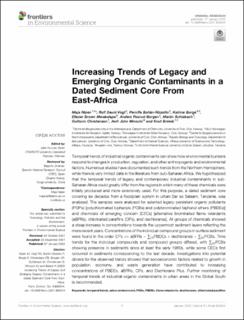| dc.contributor.author | Nipen, Maja | |
| dc.contributor.author | Vogt, Rolf David | |
| dc.contributor.author | Bohlin-Nizzetto, Pernilla | |
| dc.contributor.author | Borgå, Katrine | |
| dc.contributor.author | Mwakalapa, Eliezer Brown | |
| dc.contributor.author | Borgen, Anders | |
| dc.contributor.author | Schlabach, Martin | |
| dc.contributor.author | Christensen, Guttorm N | |
| dc.contributor.author | Mmochi, Aviti John | |
| dc.contributor.author | Breivik, Knut | |
| dc.date.accessioned | 2022-03-11T10:00:40Z | |
| dc.date.available | 2022-03-11T10:00:40Z | |
| dc.date.created | 2022-01-07T09:05:26Z | |
| dc.date.issued | 2022 | |
| dc.identifier.citation | Frontiers in Environmental Science. 2022, 9, 805544. | en_US |
| dc.identifier.issn | 2296-665X | |
| dc.identifier.uri | https://hdl.handle.net/11250/2984553 | |
| dc.description.abstract | Temporal trends of industrial organic contaminants can show how environmental burdens respond to changes in production, regulation, and other anthropogenic and environmental factors. Numerous studies have documented such trends from the Northern Hemisphere, while there is very limited data in the literature from sub-Saharan Africa. We hypothesized that the temporal trends of legacy and contemporary industrial contaminants in sub-Saharan Africa could greatly differ from the regions in which many of these chemicals were initially produced and more extensively used. For this purpose, a dated sediment core covering six decades from a floodplain system in urban Dar es Salaam, Tanzania, was analysed. The samples were analysed for selected legacy persistent organic pollutants (POPs) [polychlorinated biphenyls (PCBs) and polybrominated biphenyl ethers (PBDEs)] and chemicals of emerging concern (CECs) [alternative brominated flame retardants (aBFRs), chlorinated paraffins (CPs), and dechloranes]. All groups of chemicals showed a steep increase in concentrations towards the uppermost sediment layers reflecting the more recent years. Concentrations of the individual compound groups in surface sediment were found in the order CPs >> aBFRs ∼ ∑25PBDEs > dechloranes ∼ ∑32PCBs. Time trends for the individual compounds and compound groups differed, with ∑32PCBs showing presence in sediments since at least the early 1960s, while some CECs first occurred in sediments corresponding to the last decade. Investigations into potential drivers for the observed trends showed that socioeconomic factors related to growth in population, economy, and waste generation have contributed to increasing concentrations of PBDEs, aBFRs, CPs, and Dechlorane Plus. Further monitoring of temporal trends of industrial organic contaminants in urban areas in the Global South is recommended. | en_US |
| dc.language.iso | eng | en_US |
| dc.publisher | Frontiers | en_US |
| dc.rights | Navngivelse 4.0 Internasjonal | * |
| dc.rights.uri | http://creativecommons.org/licenses/by/4.0/deed.no | * |
| dc.title | Increasing Trends of Legacy and Emerging Organic Contaminants in a Dated Sediment Core From East-Africa | en_US |
| dc.type | Peer reviewed | en_US |
| dc.type | Journal article | en_US |
| dc.description.version | publishedVersion | en_US |
| dc.rights.holder | Copyright © 2022 Nipen, Vogt, Bohlin-Nizzetto, Borgå, Mwakalapa, Borgen, Schlabach, Christensen, Mmochi and Breivik. | en_US |
| dc.source.pagenumber | 13 | en_US |
| dc.source.volume | 9 | en_US |
| dc.source.journal | Frontiers in Environmental Science | en_US |
| dc.source.issue | 711 | en_US |
| dc.identifier.doi | 10.3389/fenvs.2021.805544 | |
| dc.identifier.cristin | 1976287 | |
| dc.source.articlenumber | 805544 | en_US |
| cristin.ispublished | true | |
| cristin.fulltext | original | |
| cristin.qualitycode | 1 | |

